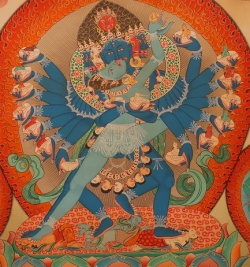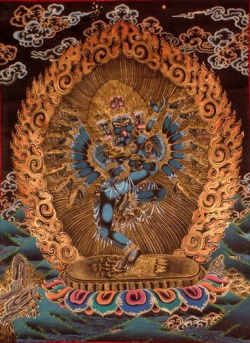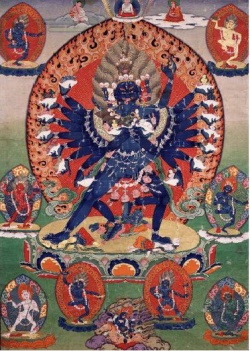Tantric Theravada in Cambodia
Tantric Buddhism became ascendant in Angkor during the reign of King Jayavarman VII. His great temples in Angkor Thom, especially the Bayon, are tantric centers.
The Hevaajra-Tantra seems to have been an important tantric practice in Cambodia at this time.
Boisselier says the brahmavihara meditations are featured in the Hevaajra-Tantra [“we shall expound the chapter on the divinities. First one should product thought of love, secondly that of compassion, thirdly that of joy, and last of all that of equanimity. Hevajra Tantra I.iii.1] and the tara-sadhana of the sadhanamala.
Why did tantric Buddhism appear so strongly in Angkor (Cambodia) at this time? The Muslim invasion of India destroyed the Tantric centers of Nalanda, Vikramasila and Odantapuri in 1200…Some of the refugee masters went to Angkor, while others went to Nepal and Tibet.
A tantric pantheon led by Hevajra, Vajrasattva, Vajradhara and Vajrapani moved center stage in Cambodia at this time, and Jayavarman had all the resources needed for this in the Phimai tradition from which his Mahidhara dynasty hailed.
The Bayon temple (Ancestor Yantra Temple) with the four-faced Buddhas looking in every direction is a manifestation of this tradition.
The presence of the Buddhist Tantric masters in Angkor may be attested from evidence in Katmandu, Nepal, where the similar tradition of the Tantric Adi-Buddha eyes look out over the city in all directions from the city from each side of the square harmika of the Katmandu’s Svayambhu Mahacaitya, and similar temples.
BP Groslier, following Jean Filliozat, speculates that the painting of the eyes on the towers in Katmandu and Patan was inspired by the refugee masters from Bengal, at exactly the same time that the giant four-faced Buddhas were carved at the Bayon in Angkor.
“It has been shown recently that it [the new form of Buddhism of Jayavarman VII) very probably consisted of the doctrine elaborated in Nalanda, then taught in Angkor – finally in Japan – by the doctors of the (Buddhist) law who had to flee before the Moslem invaders in the closing years of the 12th century. It is therefore to this school and its texts that we should turn to JayavarmanVII’s conceptions of Buddhism, and therefore for the sources of the Bayon. This is just as much as the case for the Bengali zealots who took refuge at the same time in Nepal and Kashmir, who were very probably the initiators of the stupas marked with four stylized faces, oriented to the four directions, which are the only exact parallels that can be found with the Khmer face towers.” [Groslier, BP]
Ulrich von Schroeder said of the refugee Buddhist masters of 1200:
“The annihilation of Indian Buddhism caused a great influx of refugees to Nepal who swarmed to the Buddhist monasteries of Kathmandu Valley, mostly in Patan and Kathmandu…the arrival of these Buddhist refugees was beneficial to Nepal and in many ways one of them being that among the immigrants were many eminent Indian Buddhist scholars who had salvaged valuable manuscripts and probably many cast images. There is every reason to believe that among these displaced Buddhists were also many skilled artists and craftsmen. At the same time the importance of the viharas as centers of Buddhist studies increased and the Tibetan Buddhists shifted their focus from north-eastern India to Nepal. [Ulright von Schroedder Indo-Tibetan bronzes. Visual Dharma Publications, Hong Kong.]
In the years 1197-1207, when all the Ganges valley monasteries were being destroyed, the Khmer were carving face-towers in Buddhist Bayon Banteay Chmar and other temples, and producing stone and bronze icons of Tantric deities such as Hevajra, Vajradhara and Vajrapani – all progeny of Nalanda, Vikramasila and another Indian monasteries.
“In tantric thinking, a king’s personal meditation in discovering the Buddha inside himself generates a mandala of deities, not only for himself but for the whole state. [Jayavarman was a skillful meditator and a learned Buddhist. His second wife and two sons were skilled Sanskritists who composed his three major extant inscriptions, and he is described in his inscriptions as ‘learned in the sutras’ and “a veritable Panini in his youth’ and is shown pronouncing the mantras at a public ritual.”
The apsaras (female goddess dancers) carved into the temples of Angkor are tantric-yoginis. Images of the Yogini-Hevajra cult.
History records that King Jayavarman VII entered the pinnacle of his temple at Angkor Thom every night in order to have intercourse with a “female dragon” – that is, engage in tantric meditation rites with a female partner.
Hevajra Tantra was the first of a new class of Mother Tantras that gave a strong female orientation to its mandalas. …Jayavarman’s temples were known for the special focus they gave to female officiants. The 1225 chronicle of Chau Ju-Kua, the Chinese Superintendent of Maritime Trade in Canton, contains an account of temple life:
“[in Chen-la, ie. Cambodia) the people are devout Buddhists. In the temples there are 300 foreign women; they dance and offer food to the Buddha. They are called a-nan [Skt. Ananda (bliss)]…the incantations of the Buddhist and Taoist (Shiva yogin) priests have magical powers.’”
When Cambodia later adopted Theravada Buddhism, this older strata of tantric Buddhism was subsumed and assimilated into the Buddhist traditions.


